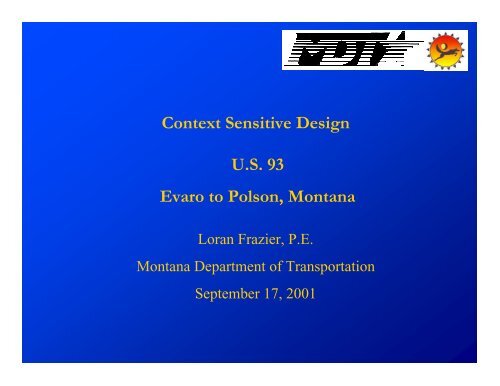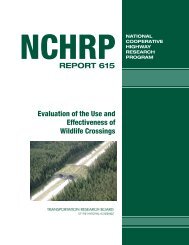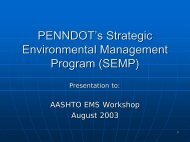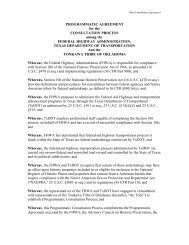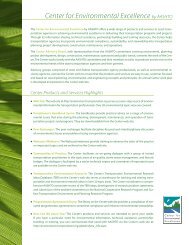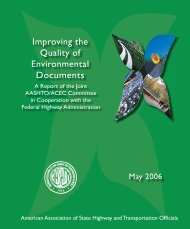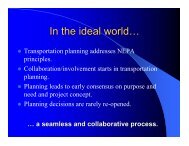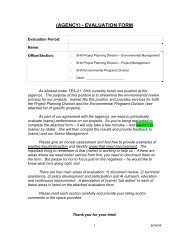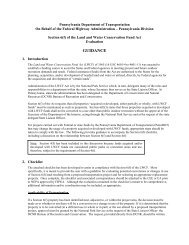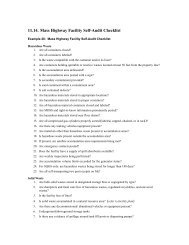Context Sensitive Design U.S. 93 Evaro to Polson, Montana
Context Sensitive Design U.S. 93 Evaro to Polson, Montana
Context Sensitive Design U.S. 93 Evaro to Polson, Montana
Create successful ePaper yourself
Turn your PDF publications into a flip-book with our unique Google optimized e-Paper software.
<strong>Context</strong> <strong>Sensitive</strong> <strong>Design</strong><br />
U.S. <strong>93</strong><br />
<strong>Evaro</strong> <strong>to</strong> <strong>Polson</strong>, <strong>Montana</strong><br />
Loran Frazier, P.E.<br />
<strong>Montana</strong> Department of Transportation<br />
September 17, 2001
Goals<br />
Provide a case-study on the innovations used<br />
on U.S. <strong>93</strong> in <strong>Montana</strong>:<br />
• means <strong>to</strong> reach a<br />
shared vision<br />
• design elements that<br />
incorporate this vision<br />
• relation <strong>to</strong> NEPA<br />
process
Project Location<br />
CA<br />
OR<br />
WA<br />
NV<br />
AK<br />
ID<br />
*<br />
UT<br />
MT<br />
WY<br />
AZ NM<br />
HI<br />
CO<br />
ND<br />
SD<br />
NE<br />
KS<br />
TX<br />
OK<br />
MN<br />
IA<br />
MO<br />
AR<br />
LA<br />
WI<br />
IL<br />
IN<br />
MI<br />
TN<br />
MS AL<br />
KY<br />
OH<br />
WV<br />
VA<br />
NC<br />
GA<br />
PA<br />
US-<strong>93</strong><br />
#<br />
SC <strong>Polson</strong><br />
FL<br />
MT-200<br />
#<br />
NY<br />
Charlo #<br />
I-90<br />
S-212<br />
S-354<br />
ME<br />
VT<br />
NH<br />
MA<br />
RI<br />
Flathead NJ<br />
CT<br />
Lake DE<br />
MD<br />
DC<br />
#<br />
Pablo<br />
S-211 #<br />
#<br />
# Arlee<br />
US-<strong>93</strong><br />
#<br />
US-<strong>93</strong><br />
Ronan<br />
St. Ignatius<br />
S-559<br />
<strong>Evaro</strong><br />
MT-35<br />
N<br />
• Project Length: 56.3 miles<br />
• Volume: 7975 vehicles<br />
• Trucks: 2% - 9%<br />
• RV’s 2% - 5%<br />
• Configuration: mostly 2-lane<br />
• Accidents: 4.8 % fatal<br />
(versus 1.7 % statewide)<br />
and 44.2 % injury<br />
(versus 37.1 % statewide)
Project His<strong>to</strong>ry<br />
U.S. <strong>93</strong> in <strong>Montana</strong><br />
• 187 miles long – Idaho <strong>to</strong> B.C.<br />
– Serves fastest growing counties in <strong>Montana</strong><br />
– Entire corridor high priority<br />
• South section …Hamil<strong>to</strong>n <strong>to</strong> Lolo<br />
– Reconstruct 33.4 miles <strong>to</strong> 4 lanes<br />
– <strong>Context</strong> <strong>Sensitive</strong> design features<br />
– First project: 1998 let<br />
– Last project: 2004 let<br />
– Hamil<strong>to</strong>n – Lolo EIS<br />
• North section …Somers <strong>to</strong> Kalispell<br />
– Reconstruct 20.6 miles <strong>to</strong> divided 4 and five lanes<br />
– <strong>Context</strong> <strong>Sensitive</strong> design features<br />
– First project: 1996 let<br />
– Last project: 2002 let
Project His<strong>to</strong>ry (cont.)<br />
Central Section of U.S. <strong>93</strong> – <strong>Evaro</strong> <strong>to</strong> <strong>Polson</strong><br />
• Entirely within the Flathead Reservation of the<br />
Confederated Salish Kootenai Tribes (CSKT)<br />
• Tribal context<br />
– Unique sovereignty and government <strong>to</strong> government issues<br />
– Cultural Aspects<br />
• Early 1980’s<br />
– Environmental reviews on separate projects<br />
– Tribe requested a comprehensive EIS<br />
• Early 1990’s<br />
– Comprehensive corridor-long EIS<br />
– State supported a 4-lane design<br />
– CSKT preferred 2-lane with some passing
Project His<strong>to</strong>ry (con’t)<br />
• August 1996 FHWA ROD<br />
“FHWA chooses <strong>to</strong> defer making a decision on lane configuration or the<br />
preservation of a corridor of land for future construction.”<br />
“Before any improvements <strong>to</strong> U.S. <strong>93</strong> between <strong>Evaro</strong> and <strong>Polson</strong> can<br />
move forward…a resolution of the differences between (the CSKT and the<br />
State) is necessary.”<br />
• August 1996 – Early 1998: 18 months of contemplation:<br />
– Millions of dollars had been spent<br />
– 15 years had elapsed<br />
– The north and south corridors were moving forward, and<br />
– People were still dying on the corridor
Project His<strong>to</strong>ry (con’t)<br />
• February 1998<br />
– The ROD was amended <strong>to</strong> support access management on non-tribal lands<br />
• November 1998<br />
– Access management plan was completed<br />
– These discussions built trust and led <strong>to</strong> a decision by CSKT and the State<br />
<strong>to</strong> reach a decision<br />
• March 2000<br />
– Tri-government team established<br />
– Skillings-Connolly hired <strong>to</strong> lead negotiation process<br />
• December 2000<br />
– <strong>Design</strong> agreement for majority of corridor<br />
– MOA signed by CSKT, FHWA, and MDT<br />
So, once the approach changed it <strong>to</strong>ok 10 months <strong>to</strong> reach<br />
a conceptual agreement.
Reaching a Shared Vision<br />
• MDT team had <strong>to</strong> understand the CSKT goals:<br />
– Linkage between Salish and Kootenai people and the land<br />
– Sensitivity <strong>to</strong> Cultural issues<br />
– Desire <strong>to</strong> preserve and res<strong>to</strong>re land for wildlife<br />
– Desire <strong>to</strong> share beauty of place<br />
• CSKT team learned of the linkage between design, safety<br />
and capacity<br />
• FHWA team learned how <strong>to</strong> flex as much as possible in<strong>to</strong><br />
NEPA
Reaching a Shared Vision<br />
(con’t)<br />
Facilitating the Visual Language<br />
• “Landscapes”<br />
– 14 big “rooms” were identified within the reservation<br />
– Each landscape had unique visual and physical characteristics<br />
• The Highway design will respond <strong>to</strong> and respect the visual<br />
and ecological qualities of these landscapes<br />
• The concept of natural and cultural landscapes spatially<br />
organized the design approach
MOA<br />
• Important Aspects of the MOA<br />
• Set up a method of working <strong>to</strong>gether, A Technical<br />
<strong>Design</strong> Committee (TDC) and Project Oversight<br />
Group (POG)<br />
• Defined <strong>Design</strong> Concepts and treatments for the<br />
environment.<br />
• New way for MDT Engineers <strong>to</strong> look at roads.<br />
• No longer just a MDT project , now a “We Thing”
HEADLINES<br />
Missoulian<br />
“US Highway <strong>93</strong> Expansion”<br />
“Kinder, gentler project”<br />
Missoulian, Missoulian,<br />
January 14,2001<br />
14,2001<br />
10
A Shared Vision<br />
“Landscapes”<br />
Along U.S. <strong>93</strong><br />
within the<br />
Flathead<br />
Reservation
Landscapes –<br />
Linkage <strong>to</strong> <strong>Design</strong><br />
By looking at the individual<br />
landscapes ideas began <strong>to</strong> form of<br />
how the highway should be<br />
influenced and respond <strong>to</strong> the land.<br />
Examples:<br />
<strong>Polson</strong> Hill – weave and traverse<br />
glacial terrain<br />
Minesinger – curvilinear design<br />
Pablo Pines – res<strong>to</strong>re pines and pull in<br />
meander edges<br />
Ronan Spring Creek – respond <strong>to</strong> the<br />
rolling terrain<br />
Important <strong>Design</strong> Elements<br />
Curvilinear design <strong>to</strong> compliment<br />
or display terrain
Cultural and His<strong>to</strong>ric<br />
Resources<br />
• To avoid having <strong>to</strong> identify individual and sacred<br />
sites, cultural information was associated with<br />
wildlife issues.<br />
• The close linkage between sacred sites and<br />
wildlife concerns is consistent with the Salish-<br />
Kootenai culture
Wildlife<br />
• Goals<br />
– Reduce mortality<br />
– Reduce habitat loss<br />
– Increase habitat connectivity<br />
• Information and data<br />
– Migra<strong>to</strong>ry patterns<br />
– Road-kill data<br />
– Ecological habitats<br />
– Construction techniques for wildlife crossings<br />
• <strong>Design</strong> result<br />
– 42 wildlife crossings are planned throughout the corridor<br />
– Range from $28,000 for a pipe or box culvert <strong>to</strong> $2.3 million for a wildlife<br />
over crossing<br />
– Five locations <strong>to</strong>taling about 14 miles of fencing <strong>to</strong> channel wildlife <strong>to</strong><br />
crossing locations
Types of Wildlife Crossings from<br />
Locations in the U.S. and Canada<br />
Examples<br />
Concrete Culverts Bridges
Types of Wildlife Crossings from<br />
Locations in the U.S. and Canada<br />
Culverts<br />
Wildlife Overpass<br />
Roads on Piers
Wildlife Crossing Locations<br />
within U.S. <strong>93</strong> Landscapes
Wildlife Crossing Locations<br />
within U.S. <strong>93</strong> Landscapes<br />
(con’t)
Fundamental Cultural<br />
<strong>Design</strong> Elements<br />
Goal: To provide a unified vision of the corridor representing<br />
the traditional ways of the tribes<br />
• Signage<br />
– Portal / Boundary Signs<br />
“Homeland of the Sqelixw “Ag Ismaknik”<br />
– Natural materials native <strong>to</strong> the area:<br />
• quarried s<strong>to</strong>ne (not river rounded)<br />
• treated wood<br />
• native vegetation
Fundamental Cultural<br />
<strong>Design</strong> Elements<br />
–Place Names<br />
• Written in Salish, Kootenai and English<br />
• Unique in color<br />
• A traditional beadwork border <strong>to</strong> the sign<br />
will be unique <strong>to</strong> Salish and Kootenai<br />
languages<br />
– Interpretive signs<br />
• Use 3 languages<br />
• Incorporate coyote logo
Fundamental Cultural<br />
<strong>Design</strong> Elements<br />
• Visi<strong>to</strong>rs Center and<br />
Interpretive Overlook<br />
– One at National Bison Range<br />
– Native materials<br />
– Horizontal profile fitting<br />
existing landscape<br />
– Parking will not intrude on view<br />
– Work of tribal artists<br />
incorporated<br />
– Corridor logo incorporated
Fundamental Cultural<br />
<strong>Design</strong> Elements<br />
Roadway Alignment<br />
• Avoid large cut and fills by following landforms<br />
• Vertical curvature<br />
– Reflects rolling landscape<br />
– Meets AASHTO standards<br />
• For divided four-lane configurations berms planted with native pines<br />
will separate the road<br />
• S<strong>to</strong>ne veneer on structures<br />
• Planted median between roadway and pedestrian features<br />
• Trees 50 years or older will be protected<br />
• All disturbed areas revegetated<br />
• All abandoned his<strong>to</strong>ric roadway sections res<strong>to</strong>red<br />
• Bike/Pedestrian within communities
Summary of <strong>Design</strong><br />
Concepts<br />
• Mostly two lane with passing lanes<br />
• Four lane divided between the two largest cities in the<br />
corridor<br />
• The 11.2 miles within Ninepipes Wildlife Preserve will<br />
identify an alternative through a supplemental<br />
Environmental Impact Statement<br />
• LOS: all sections will operated at “C” or better through<br />
2024<br />
• Safety: Estimated reduction of 1235 accidents in 20 years<br />
(fatal, injury, personal property)
Next Steps<br />
• EIS will be re-evaluated <strong>to</strong> see if there are any<br />
environmental impacts coming from the<br />
agreement that have <strong>to</strong> be studied<br />
• MDT will initiate design and ROW acquisition<br />
• GARVEE bonds will be used <strong>to</strong> accelerate<br />
construction<br />
• 8 – 9 individual projects
JAN 1999<br />
AUGUST 2001<br />
US-<strong>93</strong> EVARO TO POLSON, MONTANA<br />
Project Development Schedule<br />
1999 2000 2001 2002 2003 2004 2005 2006 2007 2008 2009 2010 2011<br />
Ac ces s Contr ol – Corridor Pr ese rva tion<br />
<strong>Design</strong><br />
Discu ssion s<br />
R/W Acquisition<br />
(Except Ninepipe, Ronan, & <strong>Polson</strong>)<br />
MO A<br />
Enviro nmental<br />
Re-Eval uation<br />
SEIS<br />
Ninepipe & Ronan<br />
Desig n M anagement &<br />
Oversight<br />
Desig n Con tr acts<br />
1 th ru 9<br />
Enviro nmental<br />
Document - Po lson<br />
Legislative<br />
Funding<br />
Concurrence<br />
Desig n M anagement &<br />
Oversight<br />
Desig n Con tr acts<br />
10 th ru 12<br />
R/W Acquisition<br />
(Ninep ipe & Ron an)<br />
R/W Acquisition<br />
(<strong>Polson</strong>)<br />
DESIGN CONTRACTS<br />
1) Vis i<strong>to</strong>r Center & Interpretive Area<br />
2) Ev aro – McClure Road<br />
3) McClure Rd. <strong>to</strong> N. End Arlee Couplet<br />
4) N. End Arlee Couplet - Vic. White Coyote Rd.<br />
5) Vic . White Coyote Rd. – S. End Ra valli<br />
6) S. End R avalli – S. St. Ignatius (Medic ine Tre e)<br />
7) S. St. Ignatius (Medicine Tree) – Vic. Red Horn Rd.<br />
8) Spring Creek Rd. (N. Ronan) – Minesinger Trail<br />
9) Minesinger Trail – MT 35 (<strong>Polson</strong>)<br />
Construction Manag emen t – Agg ressive Constructio n S ched ule<br />
(Open for discu ssion – Co uld be 5-8 years in len gth)<br />
3 Co nstruction Con tracts<br />
3 Co nstruction Con tracts<br />
3 Co nstruction Con tracts<br />
3 Construction Contracts
<strong>Design</strong> Excellence<br />
• Simultaneously advancing the objectives<br />
of safety, safety, mobility, mobility, enhancement of the the<br />
natural natural environment, environment, and and preservation preservation of<br />
community community values.<br />
4


